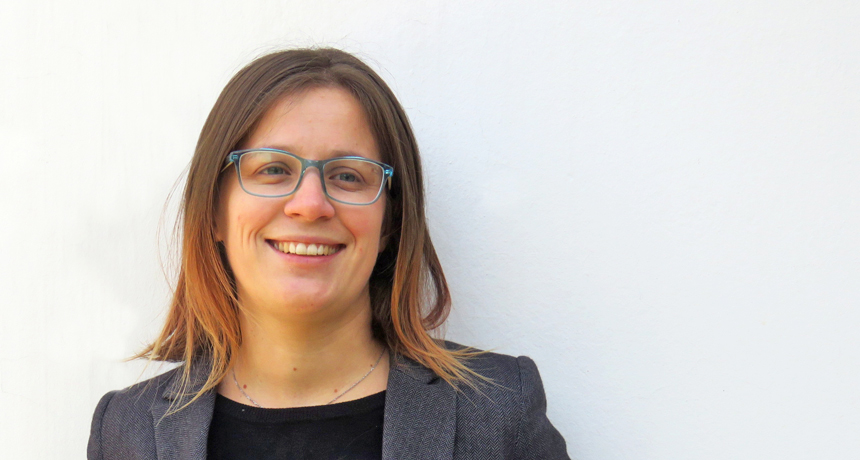Cool Job: Making stellar connections
Astrophysicist Paula Jofré reaches across disciplines to link stars across the galaxy

Astrophysicist Paula Jofré wants to find links between all the stars in our galaxy, the Milky Way.
MARÍA CECILIA ABARCA/UNIVERSIDAD DIEGO PORTALES
Paula Jofré wants to map the galactic lineage of every star in the Milky Way. It’s like tracing your family tree — if, that is, your grandparents were the exploding stars we call supernovas.
Jofré is an astrophysicist at Universidad Diego Portales in Santiago, Chile. There, she studies the inner lives and histories of stars. She measures the wavelengths of light these stars emit. That shows her which chemical elements the stars contain. That also tells her the proportions of those elements in each star.
Inspiration from art and biology
The scientist then does something unusual. Borrowing a technique from biology, she traces how the stars evolved.
Biologists can examine the DNA in ancient human remains to trace a population’s history. Jofré does something similar with stars. She uses the composition of modern stars to track how their ancestors moved around our galaxy, the Milky Way. Her best-known work, and the research of which she’s most proud, uses those elements to chart the first family tree of stars in the Milky Way.
She got the idea while a postdoc. She was attending an event at the University of Cambridge in England. It had been organized by an art history student. The focus was how scientists visualize their results. There, Jofré met Cambridge anthropologist Robert Foley. He showed her how evolutionary trees can link relationships between members of a species over time. Stars, Jofré realized, also pass down bits of themselves to successive generations. Perhaps, she thought, those generations could be traced back in time.
She and Foley soon hashed out the stellar family tree project while at dinner in a Cambridge dining hall. (The hall is “very much like a Harry Potter room,” she recalls. All the fellows even wear academic gowns that look similar to Hogwarts robes.) Stars obviously don’t procreate like animals, the pair agreed. However, dying stars do pass on their chemistry, much like parents pass along parts of their DNA to their children.
That happens because stars forge heavy elements, such as carbon and iron. When the stars die, they often explode, spreading those newly formed elements throughout the cosmos. The next generation of stars are born from collapsing clouds of gas containing those elements. That lets them pick up elements from the earlier generation.
And thus, a family is born.
Stars from the same gas cloud should have almost the same chemistry. That’s similar to how siblings share a lot of the same DNA. The analogy is close enough that Jofré, Foley and their colleagues built a three-branched tree showing the relationships of 21 stars that are siblings of the sun. They described it last year in the Monthly Notices of the Royal Astronomical Society.
The team also reported that two of the branches were known groupings. One was the Milky Way’s thin disk of stars. The other was an older thick disk that surrounds it. The third branch revealed new connections. That showed that Jofré’s technique does more than map known star relationships. The approach can reveal new information about past stellar nurseries. (Stellar nurseries are places where stars are born.)
All in the family
Paula Jofré and her colleagues borrowed tools from biology to map out chemical relationships between the sun and 21 of its sibling stars. Three main branches emerged: younger stars in the Milky Way’s thin disk (red, including the sun), much older stars that could be in the Milky Way’s more dispersed thick disk (dark blue) and a third branch that lies in between (light blue). Six stars (black) had no clear relationship to the others. More observations could help tie them in.
By expanding this approach to more groups of stars, “we could use these trees to learn something about the evolution of our whole galaxy,” Jofré says. “That has been so exciting.”
Jofré sees what other astronomers don’t
This approach is original and inventive, if a little unusual, other astronomers say.
“Paula Jofré impressed me as being very innovative,” says Kenneth Freeman. He’s an astronomer at the Australian National University in Canberra. “She sees things that other researchers do not see.”
Payel Das, of the University of Oxford, is a collaborator on the Milky Way project and a close friend. She calls Jofré “really brave” as a researcher. “She’s very confident, which is really nice. I think especially now — we’re going through this crisis of women in physics and science and all this — we need this confidence.”
Jofré has never shied away from unpopular paths. Before she graduated from an all-girls high school in Santiago, a guidance counselor spoke to her class. That counselor talked about the importance of choosing a career that would leave time for family. She said one shouldn’t, for instance, choose a career in astronomy.
“The whole class looked at me,” Jofré recalls. They knew she had been interested in astronomy since childhood. But that moment only strengthened her resolve. “This woman trying to say, please don’t do that, was for me argument to say, please do it.”
The question of whether astronomy was compatible with a family came up sooner than Jofré expected. Her first child was born before she and her partner, Thomas Maedler, finished their PhDs. Their second was born during her first postdoctoral fellowship. Being the only parents in their group of graduate students was difficult. “You feel quite lonely when you’re the only one,” Jofré says.
But contrary to the guidance counselor’s warnings, parenthood has been grounding for the two. It has even helped keep them focused on what’s important. “We’re always this little nucleus, the four of us — this little atom that is walking around,” Maedler says.
For Jofré, science has been inextricably entwined with family — not just the sun’s, but her own.







